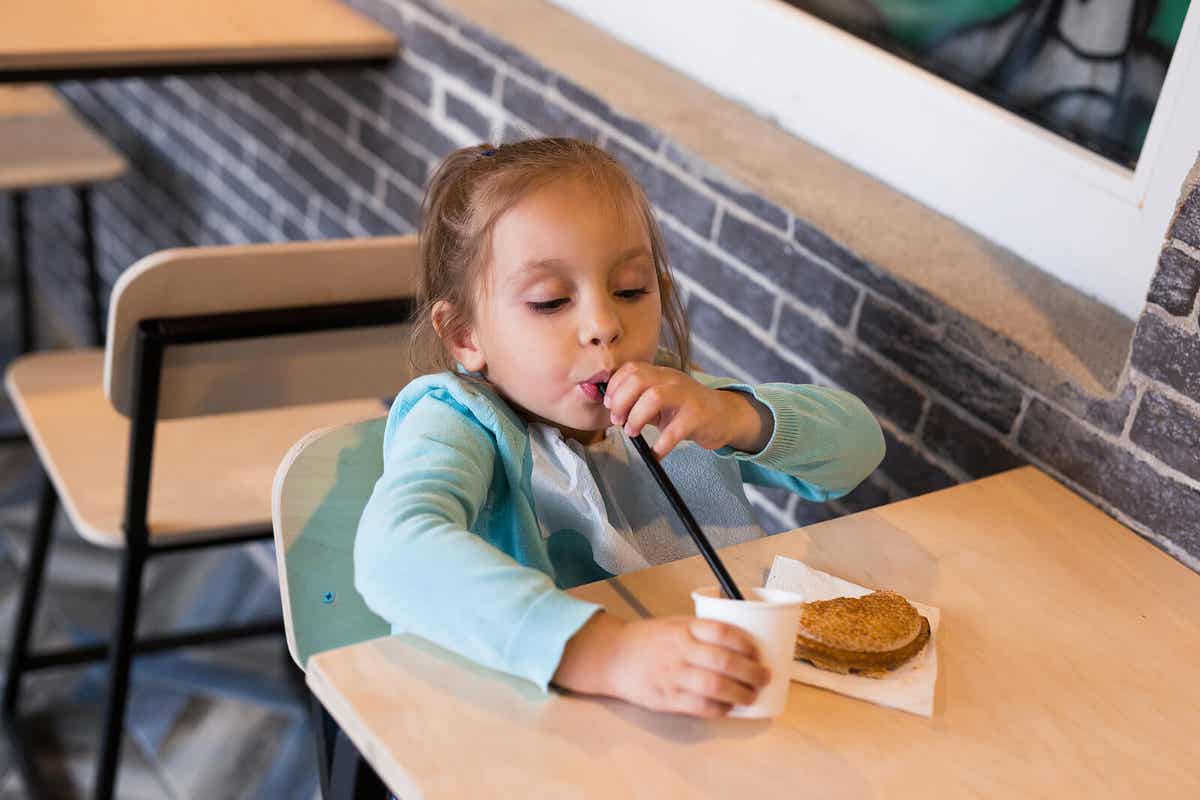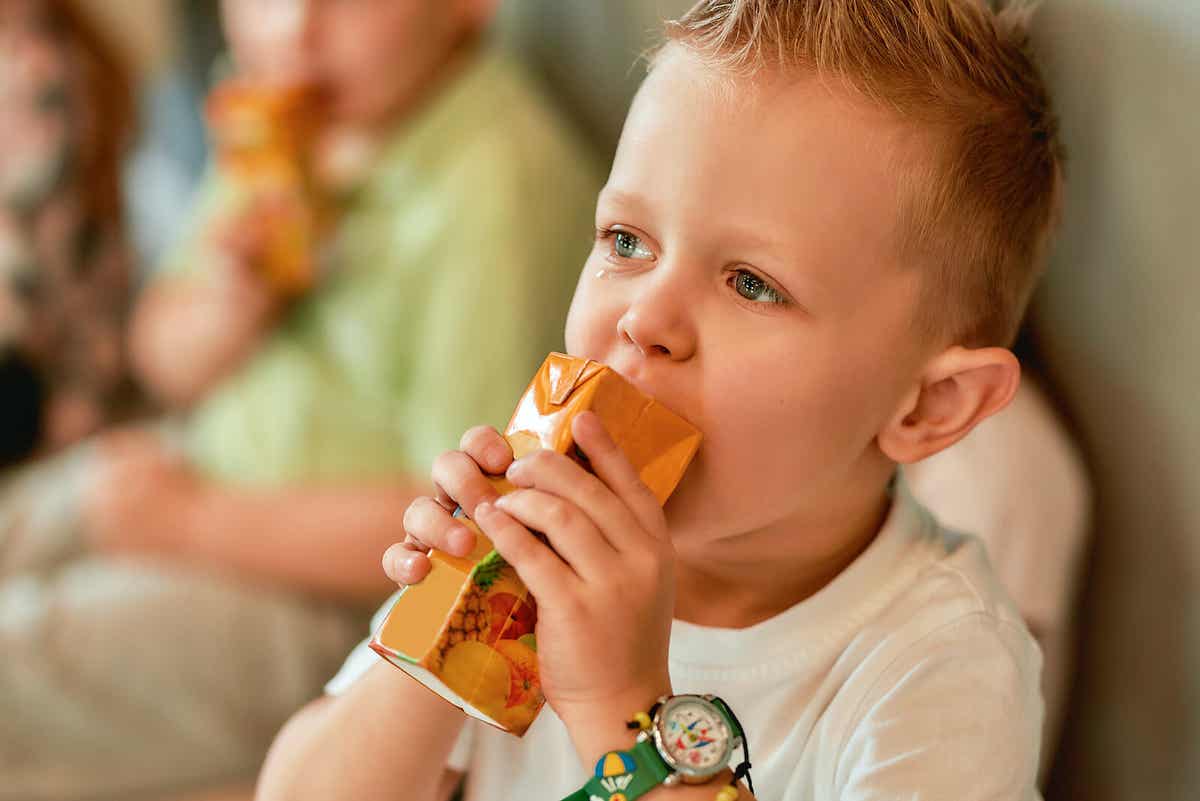The Risk of Eating Between Meals in Children

Have you ever heard the recommendation to eat 5 times a day? Some say it helps better control your hunger and be healthy. However, when it comes to children, this habit helps them get energy, as kids have lots of physical energy. In addition, it gives them the nutrients they need to grow. However, it’s not necessary, so we want you to know the risks of eating between meals for children.
The biggest problem is the type of products they tend to snack on, like juices or milk with cookies, fried and salty pastries or snacks, or sandwiches with sugary jam or deli meat.
As you can see, they have lots of energy from their sugar and fat content, as well as good flavor. But, has it occurred to you that by giving them these snacks, your kids might barely eat their meals or even skip them?
Therefore, in the long term, it can have a negative health impact. More and more, we find that kids snack in front of the TV and other screens, without realizing if they’re actually hungry or just responding to stress. So, if you want your children to grow up healthy, keep reading to discover the consequences of snacking between meals.

Snacking between meals and quality of diet in children
Although there are people who defend kids snacking between meals, as they think it keeps their kids well-nourished, the nutritional quality of their diet is actually lower. This isn’t only because of the type of products, but also because they’re displacing other healthier foods, like vegetables, fruits, and nuts.
When comparing them, even if the cookies or juices are enriched, they still have lots of sugar and will exceed the daily recommended amounts. In addition, kids eat them regularly instead of occasionally, which also worsens their health.
Weight gain, the main risk of kids eating between meals
Weight gain is one of the most studied consequences because the rates of being overweight and obese have grown among kids. Additionally, there are differences between the studies, as they involve several factors.
However, researchers agree that the risk is greater the more times a day they snack. There’s even an increase in abdominal girth, especially when taking into account the ratio of caloric intake and basal metabolism.
At the same time, you lose control of quantity if you get into a habit of eating while watching a show or playing on a tablet. As a consequence, it changes appetite regulation, as the body is constantly receiving food. This causes the body to secrete hormones to regulate the levels of nutrients in the blood and deposits.
The appearance of cavities and tooth decay
Maybe now you’re wondering what oral health has to do with snacking between meals. The relationship doesn’t have to do with the habit itself, but with the type of food you eat. First, we want you to understand that the appearance of cavities or the deterioration of tooth enamel is caused by the presence of acids. Therefore, consuming juices daily, like orange or pineapple, is the main cause.
Soft drinks are also responsible, but kids usually drink those less between meals. So, try to replace them with water as the only source of hydration.

Conclusions regarding the risk of eating between meals
Finally, we recommend that you try to limit the number of snacks your kids eat due to the risk of eating between meals for children, besides the fact that it’s hard to have food at all times.
The best way to do this is by encouraging them to eat when they’re hungry. How can you do that? Ask them, and don’t use food as a reward or a way to keep them distracted.
However, what matters is that the habits they have throughout the day are as healthy as possible, including snacks. This way, the risk decreases by replacing cookies, juices, pastries, and milk chocolate for fresh-cut fruit, a handful of nuts, a piece of cheese, hummus with carrots, an ounce of 80% dark chocolate, etc.
Also, while they’re studying or exercising, they may want to eat the 4-5 meals that are recommended. In these cases, their caloric and nutrient-loss expenditure increases, so it may be a good idea.
Have you ever heard the recommendation to eat 5 times a day? Some say it helps better control your hunger and be healthy. However, when it comes to children, this habit helps them get energy, as kids have lots of physical energy. In addition, it gives them the nutrients they need to grow. However, it’s not necessary, so we want you to know the risks of eating between meals for children.
The biggest problem is the type of products they tend to snack on, like juices or milk with cookies, fried and salty pastries or snacks, or sandwiches with sugary jam or deli meat.
As you can see, they have lots of energy from their sugar and fat content, as well as good flavor. But, has it occurred to you that by giving them these snacks, your kids might barely eat their meals or even skip them?
Therefore, in the long term, it can have a negative health impact. More and more, we find that kids snack in front of the TV and other screens, without realizing if they’re actually hungry or just responding to stress. So, if you want your children to grow up healthy, keep reading to discover the consequences of snacking between meals.

Snacking between meals and quality of diet in children
Although there are people who defend kids snacking between meals, as they think it keeps their kids well-nourished, the nutritional quality of their diet is actually lower. This isn’t only because of the type of products, but also because they’re displacing other healthier foods, like vegetables, fruits, and nuts.
When comparing them, even if the cookies or juices are enriched, they still have lots of sugar and will exceed the daily recommended amounts. In addition, kids eat them regularly instead of occasionally, which also worsens their health.
Weight gain, the main risk of kids eating between meals
Weight gain is one of the most studied consequences because the rates of being overweight and obese have grown among kids. Additionally, there are differences between the studies, as they involve several factors.
However, researchers agree that the risk is greater the more times a day they snack. There’s even an increase in abdominal girth, especially when taking into account the ratio of caloric intake and basal metabolism.
At the same time, you lose control of quantity if you get into a habit of eating while watching a show or playing on a tablet. As a consequence, it changes appetite regulation, as the body is constantly receiving food. This causes the body to secrete hormones to regulate the levels of nutrients in the blood and deposits.
The appearance of cavities and tooth decay
Maybe now you’re wondering what oral health has to do with snacking between meals. The relationship doesn’t have to do with the habit itself, but with the type of food you eat. First, we want you to understand that the appearance of cavities or the deterioration of tooth enamel is caused by the presence of acids. Therefore, consuming juices daily, like orange or pineapple, is the main cause.
Soft drinks are also responsible, but kids usually drink those less between meals. So, try to replace them with water as the only source of hydration.

Conclusions regarding the risk of eating between meals
Finally, we recommend that you try to limit the number of snacks your kids eat due to the risk of eating between meals for children, besides the fact that it’s hard to have food at all times.
The best way to do this is by encouraging them to eat when they’re hungry. How can you do that? Ask them, and don’t use food as a reward or a way to keep them distracted.
However, what matters is that the habits they have throughout the day are as healthy as possible, including snacks. This way, the risk decreases by replacing cookies, juices, pastries, and milk chocolate for fresh-cut fruit, a handful of nuts, a piece of cheese, hummus with carrots, an ounce of 80% dark chocolate, etc.
Also, while they’re studying or exercising, they may want to eat the 4-5 meals that are recommended. In these cases, their caloric and nutrient-loss expenditure increases, so it may be a good idea.
All cited sources were thoroughly reviewed by our team to ensure their quality, reliability, currency, and validity. The bibliography of this article was considered reliable and of academic or scientific accuracy.
- Julian, C; Santaliestra-Pasías, A M; Miguel-Berges, M L; Moreno, L A (2017) Frequency and quality of mid-afternoon snack among Spanish children. Nutr Hosp, 34(4): 827-33.
- Kachurak, A; Bailey, R L; Davey,A; Dabritz, L; Orlet Fisher; J (2019) Daily Snacking Occasions, Snack Size, and Snack Energy Density as Predictors of Diet Quality among US Children Aged 2 to 5 Years. Nutrients, 11(7): 1440.
- Avery,A; Anderson, C; McCullough, F (2017) Associations between children’s diet quality and watching television during meal or snack consumption: A systematic review. Matern Child Nutr, 13(4). https://pubmed.ncbi.nlm.nih.gov/27001436/
- LeCroy, M N; Truesdale, K P; Matheson, D M; Karp, S M; Moore, S M; Robinson, T N et al (2019) Snacking characteristics and patterns and their associations with diet quality and BMI in the Childhood Obesity Prevention and Treatment Research Consortium. Public Helath Nutr, 22(17): 3189-99.
- Al-Dlaigan, Y H; Al-Meedania, L A; Sukumaran Anil, S (2017) The influence of frequently consumed beverages and snacks on dental erosion among preschool children in Saudi Arabia. Nutr J; 16(1): 80.
- Murakami, K; E Livingstone, M B (2016) Associations between meal and snack frequency and overweight and abdominal obesity in US children and adolescents from National Health and Nutrition Examination Survey (NHANES) 2003-2012. Br J Nut, 115(10): 1819-29
- Kelishadi, R; Mozafarian, N; Qorbani, M; Esmaeil Motlagh, M; Safiri, S; Ardalan, G et al (2017) Is snack consumption associated with meal skipping in children and adolescents? The CASPIAN-IV study. Eat Weight Disord, 22(2): 321-28.
This text is provided for informational purposes only and does not replace consultation with a professional. If in doubt, consult your specialist.








